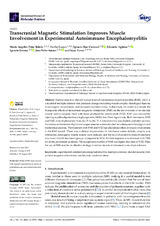Transcranial Magnetic Stimulation Improves Muscle Involvement in Experimental Autoimmune Encephalomyelitis
Autor
Peña-Toledo, María Ángeles
Luque, Evelio
Ruz‐Caracuel, Ignacio
Agüera, Eduardo
Jimena Medina, Ignacio
Peña Amaro, J.
Túnez, Isaac
Editor
MDPIFecha
2021Materia
Experimental autoimmune encephalomyelitisMultiple sclerosis
Skeletal muscle
Transcranial magnetic stimulation
Natalizumab
Oxidative stress
METS:
Mostrar el registro METSPREMIS:
Mostrar el registro PREMISMetadatos
Mostrar el registro completo del ítemResumen
Skeletal muscle is affected in experimental autoimmune encephalomyelitis (EAE), which is a model of multiple sclerosis that produces changes including muscle atrophy; histological features of neurogenic involvement, and increased oxidative stress. In this study, we aimed to evaluate the therapeutic effects of transcranial magnetic stimulation (TMS) on the involvement of rat skeletal muscle and to compare them with those produced by natalizumab (NTZ). EAE was induced by injecting myelin oligodendrocyte glycoprotein (MOG) into Dark Agouti rats. Both treatments, NTZ and TMS, were implemented from day 15 to day 35. Clinical severity was studied, and after sacrifice, the soleus and extensor digitorum longus muscles were extracted for subsequent histological and biochemical analysis. The treatment with TMS and NTZ had a beneficial effect on muscle involvement in the EAE model. There was a clinical improvement in functional motor deficits, atrophy was attenuated, neurogenic muscle lesions were reduced, and the level of oxidative stress biomarkers was lower in both treatment groups. Compared to NTZ, the best response was obtained with TMS for all the parameters analyzed. The myoprotective effect of TMS was higher than that of NTZ. Thus, the use of TMS may be an effective strategy to reduce muscle involvement in multiple sclerosis.

